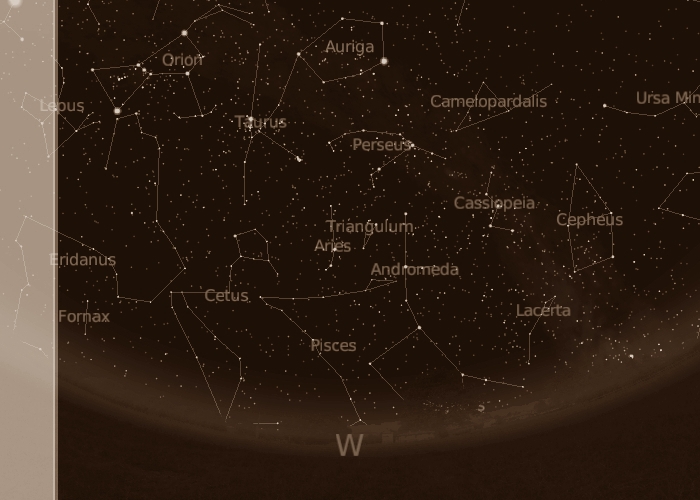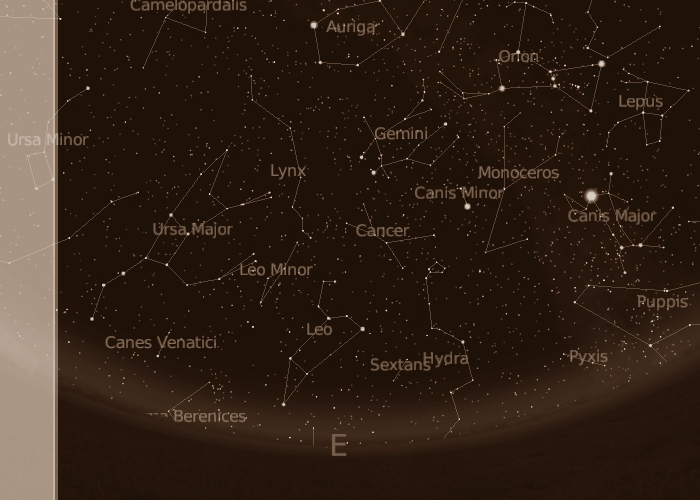Western Horizon
Eastern Horizon
![]()
Western Horizon
Eastern Horizon

It's winter now! It's the time of the great winter sky, which fills the whole sky, South. So, let's turn South, provided this horizon is available to you! The great winter sky is that part of the northern hemisphere sky which is characterized by a swarm of remarkable constellations and bright stars and which is typical of the winter period, just like the Summer Triangle is for the summer one. High, South, here comes the remarkable figure of Orion, the Hunter. Orion is the central mark of the great winter sky somehow. Orion is that large quadrilateral of stars, as three are aligned in its center. Those are the 'Orion's Belt', as the faint -albeit bright, large spot below is the famed Orion Nebula, M42. Orion is figuring a legendary Greek hunter which the goddess of the Moon and the hunt had killed by a scorpion. Hence those two parts of the sky are at the opposite of each other. Now let's take Orion as a reference. Should you follow the line of the three central stars upwards and right, you will find Aldebaran, of Taurus, the Bull, with the V-shaped Hyades, as the Pleiades, higher still, are another fine show, although high. The line of three stars downwards and left, this time. The bright star is the sky's brightest: Sirius. As the constellation is Canis Major, the Great Dog. A fine view. Let's consider now a line joining the lower right, and the upper left star of the quadrilateral of Orion. Rigel and Betelgeuse, that is. If you extend the line upwards and left, you'll find another quadrilateral of stars. That's Gemini, the Twins! Should you, then, extend the general direction of the Orion's quadrilateral upwards, here's another bright star. That's Capella, as the constellation there is Auriga, the Charioteer. Procyon, at last, is that bright star, with the constellation Canis Minor, the Little Dog, which is lying left of Orion, between Gemini and Sirius. The great winter sky really is a great sky! Some time left? Turn West, proper, where some more centers of interest may be found, like Cassiopeia, the Queen -now capital Greek E-shaped, as M31, the famed Andromeda Galaxy may keep being a target. M31, on the chart, is the grey oval. The small constellations of Triangulum, the Triangle and Aries, the Ram are fine to see, as the Great Square of Pegasus is now tending to the horizon. The southwestern part of the sky, as far as it is concerned, is allowing to Eridanus, the River Eridanus, that celestial river which takes its source to Rigel, as it meanders a long way, eventually ending in the Southern hemisphere, at Achernar. This constellation was one of Ptolemy 48 constellations, as it might have been representing the Nile river! Cetus, the Whale, albeit tending low now, is seen anchored at one bent of Eridanus, as the chain of Pisces, the Fishes is to its right. to a printer-friendly chart
West for the tropics. West for the mid-southern latitudes

Albeit the show, like we saw that, is mainly South, the eastern horizon is interesting too. As the whole southeastern part of the sky is part of the great winter sky, the small and faint Cancer, the Crab -here below Gemini- is a fine view, as it's harbouring the famed M44 open cluster, Praesepe, the Beehive, between its two central stars. M44 is the round spot on the chart. See how the head of Hydra, the Hydra, is seen in the neighbourhood. As Lynx, the Lynx, a faint constellation is high, Leo, the Lion is rising East. A fine view! Leo is finely representing the figure he's supposed to be, a crouched Lion that is! And that's not all! The Great Dipper, northeast, is well seen, along with Ursa Major, the Great Bear, as it's a good season to observe it in its entirety. Should you turn North, at last, a fine show is available further, with Draco, the Dragon grazing the northern horizon, as the Little Dipper is above. Another fine views. to a printer-friendly chart
East for the tropics. East for the mid-southern latitudes
(color maps with Stellarium; printer-friendly charts with Cartes du Ciel, Patrick Chevalley)
Website Manager: G. Guichard, site 'Amateur Astronomy,' http://stars5.6te.net. Page Editor: G. Guichard. last edited: 12/28/2010. contact us at ggwebsites@outlook.com